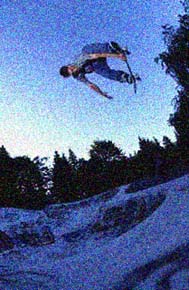If you grew up in an urban, suburban, or otherwise mostly paved environment, and particularly if you like to "thrash" and recognize the "McTwist" as something other than a McDonalds menu item, then you probably answered "d" for skateboarding -- and you were right. Skateboarding is usually thought of as a sport for urban/suburban young boys, and is conducted almost anywhere there's an abandoned cement gully or half-pipe.
"Skateboarding," writes Rolling Stone's Trip Gabriel, "is an anti-authoritarian sport virtually by definition; kids do it because they're told not to. In whatever town it becomes popular, the local  burghers ban it. No skateboarders in the Fourth of July parade! No skateboarders at the mall! And who can blame them? Your typical skater is a little twerp fishtailing down the street, sideswiping cars and pedestrians. ... Skateboarding is antischool, anti-MTV, anti-Sara Lee pound cake" (76).
burghers ban it. No skateboarders in the Fourth of July parade! No skateboarders at the mall! And who can blame them? Your typical skater is a little twerp fishtailing down the street, sideswiping cars and pedestrians. ... Skateboarding is antischool, anti-MTV, anti-Sara Lee pound cake" (76).
For those of us whose few experiences with skateboarding made us feel (and look) like a "gooney bird trying to land" (Sheehy 9), as one Newsweek columnist describes it, a brief history is (courtesy of Gabriel) is probably in order.
"The sport was first big in the mid-Sixties, when Jan and Dean crooned 'Sidewalk Surfin'.' But those original 'bun buster' skateboards were tough to ride, and the fad petered out. Then the invention of the polyurethane wheel and the wide top, or 'deck,' made skateboards more maneuverable, and a second swell, with 30 million skaters, built and crested in the late Seventies. Fast-buck artists across the land built skate parks by pouring concrete into poorly-designed swimming-pool-shaped basins for skaters to test their moves.
But in three years the sport was dead. Dead because kids didn't want to pay to skate in places with chain-link fences corralling them. Skate parks went out of business like collapsing dominoes, and skateboarders took to the streets. In the 1980s, the third wave of skater kids has sought out highway underpasses, irrigation ditches, dry graffiti-sprayed swimming pools at condemned apartment buildings -- the sort of turf that makes up the everyday landscape of kids like [East L.A.'s champion skater] Christian Hosoi. They've also built plywood 'ramps,' huge U-shaped structures thrown up in backyards in imitation of concrete culverts. Word of a site...spreads secretly from skater to skater. To broadcast a location would be to bring on the law and close the spot down." (Gabriel 74).
As the sport has grown, so has the system of meanings that is a part of skating's inner workings. "Every skater," writes Vogue's Ralph Rugoff, "wears some version of the tribal uniform: double extralarge T-shirts, absurdly baggy pants with dropped crotches that hang to midshin, boxer shorts riding high, and backward baseball hats. It's slimmer wearers have the appearance of starving cartoon characters, with spindly limbs poking through clown-size gear" (191).
It is easy to see how skateboarding as a sport could come to be associated with rebellion, marginality, and young punks. Pushed away from the mainstream of legal and social systems for most of its existence, the sport has been conducted in secret by (mostly) young males whose participation is, itself, often a form of resistance.
While many of us only see this rebellion from a mainstream perspective, those who are a part of the "lasting subculture" of skaters use the sport's meaning system as a means of expressing and understanding their relationship to the world around them. Kevin Thatcher, editor of Thrasher magazine (to which more than 400,000 skaters subscribe), admits that skateboarding has "more of a doomsday outlook. I mean, what does the future hold for kids who are fifteen now?" (Rugoff 207). "Skater kids are not kids bred on milk and cookies," Thatcher says. "They're not kids whose dads gave them batting practice out in the front yard or drove them to the ice-skating rink. It's not a father-son deal. It's just the opposite" (Gabriel 74).
Skateboarding, in this sense, is a sport/subculture whose very existence offers insights into the larger mainstream culture within which it has grown up. The meanings it holds in the mainstream cultural system and the meanings mainstream culture holds in the skater's meaning systems are telling, indeed.
Link to skateboarding-related Web page:
Return to:
 |
|  |
| 
[sports/association quiz, skateboarding, golf, gymnastics, polo, bowling, Learned Behaviors Gallery, What Is Culture? page]
 burghers ban it. No skateboarders in the Fourth of July parade! No skateboarders at the mall! And who can blame them? Your typical skater is a little twerp fishtailing down the street, sideswiping cars and pedestrians. ... Skateboarding is antischool, anti-MTV, anti-Sara Lee pound cake" (76).
burghers ban it. No skateboarders in the Fourth of July parade! No skateboarders at the mall! And who can blame them? Your typical skater is a little twerp fishtailing down the street, sideswiping cars and pedestrians. ... Skateboarding is antischool, anti-MTV, anti-Sara Lee pound cake" (76). |
|  |
| 